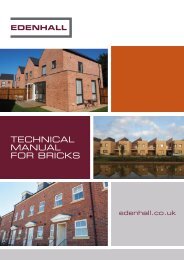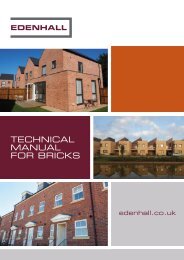Create successful ePaper yourself
Turn your PDF publications into a flip-book with our unique Google optimized e-Paper software.
edenhall.co.uk<br />
7.13 Mortar<br />
A 1:1:6 (mortar designation iii/compressive strength class M4) is adequate for most facing brick locations. Lime<br />
enhanced mortars have more capacity to absorb small degrees of movement and are recommended. This mortar<br />
designation allows the location of movement joint centres to be at 7.5 – 9.0 metre centres or greater depending on<br />
openings and other factors.<br />
Higher strength mortars i.e. 1:¹⁄₂:4-4¹⁄₂, class M6, should be used with Engineering Quality bricks, including sulphate<br />
resisting properties for Class 3 conditions.<br />
Workability of the mortars should be adjusted to accommodate the density and absorption of the bricks, which<br />
should be laid in a dry condition. Retarded or silo based mortars should be used in accordance with the suppliers’<br />
recommendations.<br />
Further information on Mortar Types and Profiles is detailed in <strong>Technical</strong> Bulletin BTB 4.<br />
7.14 Use Below DPC<br />
All Facing bricks, Common bricks, Engineering Quality bricks and Dense Coursing bricks are suitable for use below<br />
and within 150mm of damp courses as well as in superstructures. Lightweight Coursing bricks should not be used in<br />
these locations.<br />
7.15 Brick Bonds<br />
Although normal stretcher bond is the most common, alternative bond patterns are also available if a more<br />
decorative appearance is required. Some of these bonds demand the more prevalent use of headers and it is<br />
recommended that the designer discusses this with the <strong>Edenhall</strong> sales staff prior to specification. Bonding patterns<br />
should be maintained at openings - broken bonds increase the risk of cracking.<br />
7.16 Cavity Insulation<br />
The BRE Good Building Guide, GBG44, Part 2, Table 3 details the maximum recommended exposure zones for<br />
various types of insulated walls. For facing masonry walls, eg. facing bricks with tooled flush joints, the maximum<br />
recommended exposure zone for built in cavity fill is Zone 3. For exposure zones greater than this then full cavity fill is<br />
not recommended.<br />
7.17 Site Guidance<br />
Detailed guidance on the practical use of <strong>Edenhall</strong>’s concrete bricks is provided in BTB1 “Good Site Practice<br />
Guide”.<br />
35







